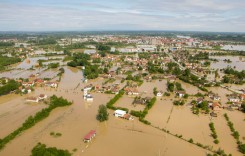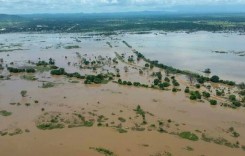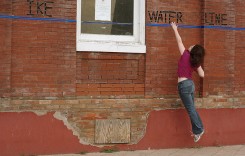In December 2014, a FloodList article highlighted flooding threats to a number of airports internationally.
A Eurocontrol study in 2008 (“Challenges of growth” environmental update study, January 2009) identified some 34 local, regional and international airports, including Marseille-Provence Airport and London City Airport, that were at risk of being affected by sea level rise. The U.S.’s National Climate Assessment for 2014 reports, “Thirteen of the nation’s 47 largest airports have at least one runway with an elevation within the reach of moderate to high storm surge“ and notes that sea-level rise will pose a threat to low-lying airports in the New York metropolitan region, the Bay Area in California, south and central Florida, New Orleans and Hawaii.
What can be, and is being, done to reduce this risk?
Characteristics of Airports
Airports, by the very nature of their function, require a large area of very flat land to enable aircraft to take off and land safely. Historically, airports have been located in ‘reclaimed’ portions of wetlands, marshlands and floodplains, or close to other large water bodies such as lakes and the ocean, since this is generally where the flattest land can be found.
In addition to being the flattest land in an area, these locations also tended to represent the cheapest large tracts of land, since they are unsuitable for other types of development. According to Lou McNally, Assistant Professor of Applied Meteorology at Embry-Riddle Aeronautical University in Florida, when some of the largest U.S. airports were first constructed in the 1920’s through the 1940’s, “the nearby city would tell you to build your airport in a swamp”. Newark Liberty International Airport—once the world’s busiest—was built on 27.5 hectares of marshland, about 24 kilometres outside Manhattan.
Given that half the world’s population lives within 60 km of the sea, and three-quarters of all large cities are located on the coast, many of the world’s large international airports are located close to sea level. Examples are Bangkok’s Don Mueang International (3m above mean sea level), San Francisco International (4m amsl), Osaka’s Kansai Airport (5m amsl), Sydney’s Kingsford Smith Airport (6m amsl), Seoul’s Incheon International (7m amsl), Hong Kong’s Chep Lak Kok International (9.2m amsl), Jakarta’s Soekarno-Hatta (10m amsl) and, of course, Amsterdam’s Schipol International Airport which is actually 3m below mean sea level.
Because airports require a large amount of capital investment, and often represent strategic installations required for more functions than only passenger and freight transport, such as oil rig supply, search and rescue, and aerial firefighting, they cannot easily be relocated, nor can they afford to be out of service for any length of time.

Flooding Threats To Airports
Recent studies have indicated that sea levels may rise faster than earlier predicted if the rate of greenhouse gas emissions is not curbed. A 2013 analysis by the New York City Panel on Climate Change reveals that sea levels in New York may rise by as much as 11 inches (27.5cm) in the 2020’s, and by more than 30 inches (76cm) by 2050.
While this may not appear a large amount, it must be borne in mind that the level of a storm surge will be significantly higher than the future sea level itself. In addition, the encroachment of urban development to surround airports that were originally constructed outside built-up areas, has led to increased levels of stormwater runoff in catchments around these airports, leading to higher risks of flooding. An increase in the severity of rainfall events accompanying climate change adds to the likelihood of flooding in such contexts.
According to a study forming part of the ‘Adapting to Rising Tides’ Project, funded by the San Francisco Bay Conservation and Development Commission and the NOAA’s Coastal Services Center, general aviation facilities and runways at Oakland International Airport could be flooded by new daily high tides with just 16 inches (40cm) of sea level rise, “which is within the range of most mid-century projections”. In addition, storm events coming on top of the 40cm of sea level rise could render the main airport access roads impassable, the report found.
A further risk is land subsidence at airports constructed on ‘reclaimed’ land, such as Japan’s Kansai International Airport, built on an artificial island in Osaka Bay in the late 20th century. The passenger terminal was reported to have sunk by nearly 12m in the six-year period following its opening in 1994, compared with initial estimates of a ‘settling’ of 11.5m over a 50-year period.
These factors pose a significant threat to the future viability of many coastal airports, as well as those located in the floodplains of large rivers.
And it is not just the airport facilities themselves that are at risk, but also “the networks of access roads and public transportation systems that transport airport workers and passengers to and from the facilities”, according to Klaus Jacob, an expert in natural disasters at Columbia University and an advisor to New York City and the state of New York.
Impacts of Flooding
The impacts of flooding on the operation of an airport take many forms, the most obvious of which is the disruption of air traffic. This in itself can cause severe economic losses in terms of passenger and freight traffic.
Even if a runway is clear of water, damage to airport infrastructure such as landing lights, radar and navigation installations and communications networks will also inhibit the passage of aircraft. Flooding of airport terminals, emergency power installations and inter-terminal transport routes will also disrupt operations and shut down airports. As was mentioned earlier, flooding of access roads and transport networks surrounding the airport can also lead to down-time for an airport.
Finally, as was demonstrated in the aftermath of Typhoon Haiyan in the Philippines, the closure of an airport due to flooding hampers the delivery of disaster relief supplies, impacting negatively on surrounding communities well beyond the airport itself.
Costs Arising From Airport Flooding
In a presentation to the Australasian Coasts and Ports Conference in Auckland, New Zealand, in September 2015, it was reported that the San Francisco Bay Area Council Economic Institute had calculated that a severe (1-in-150-year) multi-day storm event could result in delay costs in the order of US$86m arising from flooding at two airports, San Francisco and Oakland (Estimating Flood Impacts: A Status Report, Berkman & Brown, The Brattle Group). It was noted, however, that these costs were “relatively low”, as they arose from delays amounting only to hours rather than days, and that damage to airport infrastructure was not expected.
In February 2016, the UK Environment Agency published a non-technical report on the 2013-2014 flooding of southern England and Wales, in which it estimates that the economic impact of the flooding of two airports, Gatwick and Shoreham, was in the order of £3.2m, with damage to electrical systems supplying Gatwick’s North Terminal resulting in the cancellation of 72 departing and 73 arriving flights. The cost is the sum of £250,000 in direct costs to Gatwick Airport as a result of disruption and £3m in welfare costs to 16,000 Gatwick passengers affected by flight cancellations.
Closure of an airport for any reason, including as a result of flooding, also has indirect impacts on the operations and finances of other airports. For instance, in a case study presented at the 13th World Conference on Transport Research in Rio de Janiero in July 2013 (Economic effects and costs of a temporary shutdown of an airport: De Langh, Struyf, Sys, Van De Voorde & Vanelslander), it was noted that the closure of several US east coast airports by Hurricane Sandy for up to 5 days in October/November 2012 resulted in the cancellation of 18 passenger and 19 freight flights from Brussels International Airport in Belgium. The authors calculated that up to 6,464 outgoing and transit passengers could have been affected from this airport alone. Unfortunately, the authors were unable to extract empirical values from the affected airlines.
In addition to airlines and their clients, potential losses from airport closures also accrue to service providers, concession-holders and transport services; these costs are difficult to quantify, but are costly nonetheless, affecting the livelihood of many, often small-scale, businesses.
Options for Protection Against Flooding
Options for addressing the risk of flooding of airports range from the mundane to the magnificent – from increasing stormwater management capacity to building floating airports. However, apart from improving stormwater systems or relocating entire airports, the options mostly fall within a set of categories identified in a study commissioned by the European Community in 2009-2012. In the 2013 FloodProbe report (PDF) “Technologies for flood-proofing hotspot buildings”, possible solutions for airports are listed as wet proofing, dry proofing (these two options not applicable to runways), stilts, mounds, floating structures, amphibious structures, temporary barriers and permanent barriers.
Given the dynamics of climate change and the costs of designing for a worst case scenario, it is generally accepted in the industry that complete flood-proofing of airports is not feasible. Therefore many airport operators seek to increase the ‘resilience’ of the airport to flooding and other disasters, ensuring rapid recovery and restoration of services.
In order to remain competitive, however, airport operators need to strive to minimize the frequency of disruptions due to flooding. Richard Barone, director of transportation programs at New York City’s Regional Plan Association, warns of airlines demanding that airports address flooding risks, and choosing hubs based on which ones actually do so. “National air space and global air space are really one connected system. If a major hub like New York has weekly delays because of flooding, it’s conceivable that carriers would re-route air traffic or scale back their presence, and that would have profound effects for the region.”
Relocation
Relocation of a major airport is the ultimate, but probably the most costly solution to flooding, and doesn’t represent flood-proofing per se. Barone points out that there is the inherent risk of inconvenience de-railing the process. He cites the example of Montreal which proposed in the 1970’s to replace Dorval “with a larger and more modern structure further from the city, the plan failed because customers and airlines found it inconvenient.”
Nevertheless, several cities have relocated their main airports, with varying degrees of success (the risks of settling and subsidence of new airports built on reclaimed land have been noted earlier), and often in the face of fierce opposition from surrounding communities and landowners. In some cases the land was acquired decades earlier and flight corridors reserved to reduce negative impacts. For example, King Shaka International Airport in Durban, South Africa, is built on land to the north of the city that was acquired in the late 1960’s when it was under sugar cane plantations, while the airport itself was only completed in 2010.
Elevation
A possible alternative to in situ flood-proofing could be for runways to be raised or partially elevated, in combination with the construction of a dike and levee system, according to Klaus Jacob.
This idea is echoed by Barone, who says that, in the long term, “there will be a need to look at whether we can build them up, to raise portions to protect them from regular flooding.”
Proven techniques and technologies exist for the elevation of existing and new buildings, such as building on stilts or mounds. Whilst this is common with dwellings and small commercial buildings, the concept of raising an entire airport terminal is somewhat more daunting. It may be possible to raise an airport terminal in phases, but when it comes to raising the level of a runway, the element of disruption of an airport’s core function makes this a problematic option, except when constructing a new runway at a higher elevation, or when extending an existing runway such as was the case at Fort Lauderdale-Hollywood International Airport in 2013/2014.
Runways do, however, need to be re-paved periodically, typically every 8 to 10 years, and this could possibly provide a window of opportunity for raising the level of one runway at a time, if circumstances permit given the extra time involved.
Increased Stormwater Capacity
One of the keystones of improving airport flood protection is increasing the capacity of stormwater systems. This, however, may not be a total solution for a number of reasons.
Engineers must design adequate drainage systems not just for floodwater from rainfall but also from overflow from surrounding bodies of water, says Stephen Emery, an engineering consultant and director of the consultancy Kubu Australia Pty, Ltd., based in Perth. Flood and storm hardening studies are “pretty standard, boring and slow engineering tasks,” he adds—and for which it is often difficult to get approval.
Although Penang International Airport underwent a massive US$80 million upgrade between 2010 and 2012 that included a new drainage system and an elevated departure hall, parts of the airport still experienced flooding three times in 2013, six times in 2014, and again as recently as July 2016. Taipei’s Taoyuan International Airport terminal was flooded in June 2016, despite it not being near a large water body, apparently after building contractors inadvertently dumped rubble in a drainage channel.
The new $560 million terminal at Jakarta Airport flooded just days after it was opened after drainage systems were overrun, inundating the arrivals area on Sunday 14 August.
Amsterdam’s Schiphol Airport is served by more than 240km of drainage structures and has a massive pumping system that can quickly expel the water that manages to collect inside the surrounding levees. Nevertheless, the airport still isn’t considered flood proof — but it is flood resistant, and planners and officials in Holland have learned to live with the presence of water and they have designed systems capable of quickly rebounding from flood events, such as waterproof electrical equipment and elevated critical systems.
Improved Waterproofing
As with Schipol Airport, more airport operators are realizing the need to protect key infrastructure from the effects of flooding, as part of the airport’s resilience.
Here a distinction must be made between the categories of ‘dry flood-proofing’ and ‘wet flood-proofing’, as found in the FloodProBE ‘hotspot’ document. The concept of ‘wet flood-proofing’ envisages the lower floor of a building being ‘sacrificed’ to flood events, in that it is designed to let water flow freely through it during flooding, with minimum impediment. The space is thus only used for temporary purposes such as parking, with utilities located in raised positions above expected flood levels (which should not exceed 3m). This option is not feasible for an airport, however, where access to the terminal building is critical to its operation, and a safe parking area is a requirement of most clients.
‘Dry flood-proofing’ refers to a situation where flooding is not expected to exceed a depth of one metre, and water is prevented from entering a building by temporarily closing exterior openings in the building with waterproof barriers. This option is being used to an increasing extent at airports, generally for protecting utility buildings and infrastructure, and is discussed further in the section on Flood Barriers.
Not everything can be “flood-proofed,” advises Carol A. Lurie, senior planner/principal with the firm Vanasse Hangen Brustlin. “Some facilities, such as the airfield, are going to flood. But when the floodwaters recede, what condition will everything be in? The key is to understand what can be protected and what can’t be protected, and making decisions where the best investments need to go.” She adds that airport officials have to consider “how buildings and facilities need to be designed so they are more resilient – such as putting critical infrastructures on a roof.”
Flood Barriers
Flood barriers can take a variety of forms, from sandbag walls, to earth levees to concrete walls, but these are not feasible for all locations around an airport. As Jacob points out, protecting an airport against the threat of a storm surge is not as easy as simply building a tall sea wall, since airliners have to be able to safely clear such a wall or levee when landing or taking off.
As an alternative, a modular system of temporary barriers can be erected along sections crossing flight paths only for the duration of the threat of flooding, and can be removed when not required, leaving flight paths clear again.
Such barriers are being used at an increasing number of airports, including San Francisco International and Gatwick airports. At the latter, following the flooding of winter 2013/2014, Gatwick Airport Limited identified a number of risk areas requiring protection, the most pressing being the basement level below the main terminal buildings, containing offices, rental storage units, electrical and equipment rooms. The solution has been to install a framework for modular, removable neoprene coated flood barriers which can be quickly deployed and easily replaced. The concept has subsequently been extended from initial installation at landside facilities to include some airside facilities as well.
A modular floodwall, capable of being erected within 48 hours, was completed in 2009 at the Downtown (Homan Field) airport in St Paul, Minnesota, after the airport had been flooded by the adjacent Mississippi River three times between 1993 and 2001. A project to construct an earthen levee and a permanent floodwall, as well as pumps and dredging of the river to accommodate displaced floodwater, would have cost a total of US$42 million, and faced strong opposition from local communities. Instead, the removable barrier was part of a US$24m project to protect the airport’s three runways from the river and has already been successfully deployed several times since its installation, including twice in 2010.

Floating Runways / Airports
One of the most innovative, and some would say far-fetched, proposals for resolving the lack of available land for relocating or extending coastal airports is that of building floating runways or airports off-shore. Several proposals have been made over the years, such as floating runways for expansion of San Francisco International, a floating airport off the coast of San Diego, and a floating airport in the Thames Estuary to replace Heathrow Airport in London.
The closest to realization for any such project has been the Tokyo Bay Megafloat project, in which a Very Large Floating Structure (VLFS) supporting a 1,000 metre long runway was constructed in 2000 as a ‘scale model’ for a 5,000 metre long floating airport containing a full-length 4,000 metre class international airport runway. This came after extensive computer-based modelling (including using the JAL flight simulator) of a full-sized floating airport had raised issues that required physical testing, including hydro-elastic response, influence of any hydro-elasticity on Instrument Landing Systems (ILS) and Precision Approach Path Indicators (PAPI), effect of hydro-elasticity on aircraft landing and taking off, and environmental impacts.
The 1,000m long Megafloat was between 60m and 121m wide with a total area of about 8.5 hectares, and only 2m deep. Moored in relatively shallow water the steel structure was tested exhaustively with a range of short take-off and landing (STOL) aircraft such as Beechcraft 99, Dornier, Islander and Dash Eight “commuter” types. Pilots found the floating airport indistinguishable from a conventional airfield, and in a March 2001 final report, it was stated that a full-sized 5, floating airport was entirely feasible. The runway was subsequently dismantled and some of its modular components re-purposed for other floating structures such as jetties.
Could VLFS be the future for airports, since they don’t take up any land area and, because they float, are not affected by sea level change? The Megafloat was located in the relatively protected waters of Tokyo Bay, but the San Diego proposals place the VLFS 3 or 10 nautical miles offshore in the Pacific Ocean, and have not received serious consideration because of concerns regarding fuel supply logistics, access safety and pollution potential. According to Keith Wilschetz, Director of Airport Systems Planning for the San Diego Regional Airports Authority in 2007, the concept might be workable in 20 to 40 years’ time, but given the potential cost of such a project, for the Airport Authority there are still too many unknowns. “Maybe it would work on a computer,” Wilschetz said. “But do we want to dedicate $20 billion to that risk?”
Conclusion
Clearly, there is no single solution for resolving flooding threats to airports, each situation is context-specific and must be evaluated on its own merits.
Trinity Graham, Technical Director of Water Services at Aurecon in Australia recommends that, owing to the uncertainty of the timing and magnitude of climate change projections, airports should develop climate change adaptation plans that “incorporate trigger points based on ‘at what level’ action should be taken, rather than time-specific actions to adequately plan for critical risks”. This would involve “implementing base case and diligent monitoring tools, which includes being aware of mean sea level changes and monitoring groundwater and salinity levels, to identify action trigger points.”
“Airports will need to consider risks and action trigger points associated with critical infrastructure assets, including runways, taxiways/aprons, terminal buildings and coastal infrastructure such as sea walls, on a case by case basis”, she adds.








